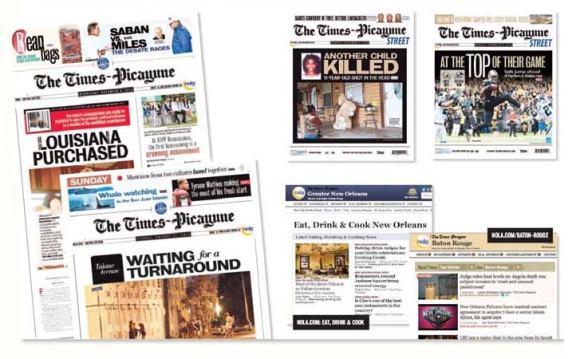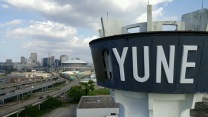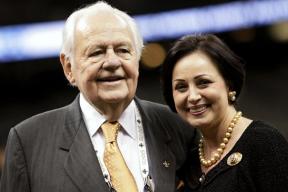
1/6/2014, 2:50 PM CST: Information about the disappearing NOLA.com blog post about the click bait AntHillArt.com’s affect on NOLA.com’s traffic below in red and underline..
12/24/13 5:59 PM CST: Additional information via a sharp-eyed insider below in red and underline.
12/23/13, 12:37 CST: Clarification to the original post added below in red and underlined type.
As USA Today media reporter Roger J. Yu concluded a reporting trip to New Orleans for an upcoming article about the extraordinary newspaper war now raging there, NOLA Media Group President and Times-Picayune Publisher Ricky Mathews Sunday published a year-end recap to readers.
The timing of Mathews’ missive, vis–à–vis Yu’s visit, is suggestive of the preemptive strike

NOLA Media Group President and Times-Picayune Publisher Ricky Mathews
NMG Vice President of Content and Times-Picayune Editor Jim Amoss penned almost exactly one year ago. Amoss’ commentary came a day before a long-anticipated “60 Minutes” segment aired about the poorly executed transformation of the then-175-year-old, Pulitzer Prize-winning newspaper into a “digital first” enterprise.)
Despite NMG’s fierce focus for the past year-and-a-half on NOLA.com, Mathews’ commentary was not available on the website, but only via the printed newspaper and the e-edition. (A PDF of it, downloaded from the e-edition, can be accessed by clicking this link: ToOurReaders_RickyMathews2013Dec22.) (CLARIFICATION, 12/23/13: Although it didn’t appear on NOLA.com, Mathews’ letter can be found at NOLA Media Group’s corporate site at http://www.nolamediagroup.com/about/, and on page A14 of the newspaper’s Dec. 22 print edition.)
Clocking in at 844 words (about half the length of a banner, front-page commentary directed at readers shortly after he assumed the top spot in the summer of 2012), Mathew opened his latest dispatch with a glowing account of what was at stake when digital first began, and what has been accomplished:
A little more than a year ago, we stepped boldly into the rapidly changing digital world. Our future as a viable news entity was at stake. We launched a new approach to delivering news and connecting our readers with our advertisers.
As we approach the end of the first year of operation in our new world, we are well on our way toward assuring our long-term ability to provide vital news and world-class advertising solutions to the communities we proudly serve.
Mathews full-page letter detailed major editorial projects undertaken by NMG in the past year, including wall-to-wall coverage of the 2013 Super Bowl (held at the Louisiana Superdome) and all of the fun and frivolity surrounding it; breaking news coverage of a horrific Mother’s Day shooting in New Orleans; and an investigative series with TV partner WVUE for which an online, reader-accessible database of campaign contributions was created.
He went on to say that home delivery of the newspaper “has grown for four (soon to be five) consecutive months, and we are reaching more than 500,000 readers in print each week.” (For the six months ending Sept. 30, the most recent report the newspaper filed with industry auditing group Alliance for Audited Media, The Times-Picayune reported an average print circulation of 130,881 on Sundays, 115,499 on Wednesdays, and 115,877 on Fridays, the three days of the week it now publishes. That totals to 362,257 for the average week during that period.)
Mathews reported that NOLA.com’s website audience grew to more than 4.5 million unique users a month, with more than 2 million accessing the site or its apps through smart phones and tablets. (NMG had 2.6 million unique users during the month of September – again the most recent numbers available – according to the latest AAM report the company filed. ADDITIONAL INFO: Nationally recognized web analytics company Quantcast, reported the NOLA had the following unique users Nov. 23-Dec. 22. Although Mathews did not specify a time frame for his figure, the latest Quantcast number of 5.9 million is significantly higher than Mathews’ stat:
TOTAL Web
|
5,853,704
|
|
Mobile
|
2,887,086
|
|
Online
|
2,966,618
Source: Quantcast
|
ADDITIONAL INFO #2, 12/24/13: A sharp-eyed reader alerted me that NOLA.com’s past unique visitor figures cited above via Quantcast were anomalously inflated by an aggregated video courtesy of a site called AntHillArt.com. NOLA.com acknowledged the click-bait generated 1.3 million page views in 30 hours, “which at least Ricky Mathews was honest enough not to claim” in the stats he cited in his reader letter, my tipster noted. According to Quantcast, NOLA.com attracted 3.7 million unique visitors and 22 million page views during the month of November, the most-recent full calendar month for which statistics are available.
Additional INFO #3, 1/6/14: Sometime after my 12/24/13 update (above) went live, the link on the NOLA.com blog post acknowledging the AnHillArt.com click bait was disabled. (It apparently was on a publicly available section of the site, but intended primarily for internal audiences.) You can read a screen grab of the original post by clicking here.
Mathews also reported that NMG’s newly beefed-up offerings in Baton Rouge – including a substantially larger staff there, the ability for NOLA.com readers to specifically choose to view news from that community, and a weekly entertainment tab named BR – has resulted in a 40% larger audience in the state capital in the past year.
NMG’s online offerings have been the target of criticism and derision, but Mathews reports they’ve improved considerably:
We have made dramatic improvements to the digital experience for our readers across all platforms, with new photo galleries and improved video players; responsive design that allows easy reading whether on tablet, desktop or phone; and state-of-the-art commenting systems that allow for real-time conversations among our writers and readers.
Mathews also boasts of employing more than 1,000 employees and independent contractors through NOLA Media Group and Advance Central Services Louisiana, the two companies corporate owner Advance Publications formed when “digital first” was implemented. (NOLA Media Group is the online newsgathering arm, while ACS oversees everything related to the printing and distribution of the newspaper, along with HR. the print edition and its support services, including printing and delivery.) The newspaper’s total full-time employee (e.g., those receiving full-time wages and benefits) headcount dropped 30% after “digital first,” and a number of undisclosed independent contractor newspaper carriers also lost their routes. The newsroom has made some hires since the transformation, but the organization now employs more freelancers and stringers on a contractual basis since the changes, so it’s unclear exactly what portion of that 1,000 are full-time employees. Based on figures I compiled for my book and those disclosed by NOLA Media Group, full-time employees with benefits probably now total between 550 and 600.

Imagery that accompanied Ricky Mathews’ Dec. 22, 2013 letter “To Our Readers”









 NOLA.com | The Times-Picayune today carried out its expected third round of layoffs since its “digital first” transformation in September 2012, letting go 37 full- and part-time editorial employees, or “21 percent of the overall content operation’s full-time employees,” NOLA Media Group President Ricky Mathews
NOLA.com | The Times-Picayune today carried out its expected third round of layoffs since its “digital first” transformation in September 2012, letting go 37 full- and part-time editorial employees, or “21 percent of the overall content operation’s full-time employees,” NOLA Media Group President Ricky Mathews  Advance Publications gave journalists at the Huntsville Times, Birmingham News and Mobile Press-Register their walking papers today (Aug. 18). The layoffs are expected to be precursors to terminations at The Times-Picayune later this year or in early 2016.
Advance Publications gave journalists at the Huntsville Times, Birmingham News and Mobile Press-Register their walking papers today (Aug. 18). The layoffs are expected to be precursors to terminations at The Times-Picayune later this year or in early 2016. consolidating its Alabama operations, its Mississippi Press and The Times-Picayune into the Southeast Regional Media Group, Lagniappe Co-Publisher/Managing Editor Rob Holbert reported.
consolidating its Alabama operations, its Mississippi Press and The Times-Picayune into the Southeast Regional Media Group, Lagniappe Co-Publisher/Managing Editor Rob Holbert reported.


 Edmonds also notes that “Siegel backed off
Edmonds also notes that “Siegel backed off  year increase in unique visitors for the first half of 2015.
year increase in unique visitors for the first half of 2015. 

 When NOLA Media Group in August announced it was reviving the Saturday and Monday printed, home-delivered editions of The Times-Picayune,
When NOLA Media Group in August announced it was reviving the Saturday and Monday printed, home-delivered editions of The Times-Picayune, 



